
A view of damaged buildings seen through the rain, in Raqqa, Syria, on Friday, May 11, 2018.
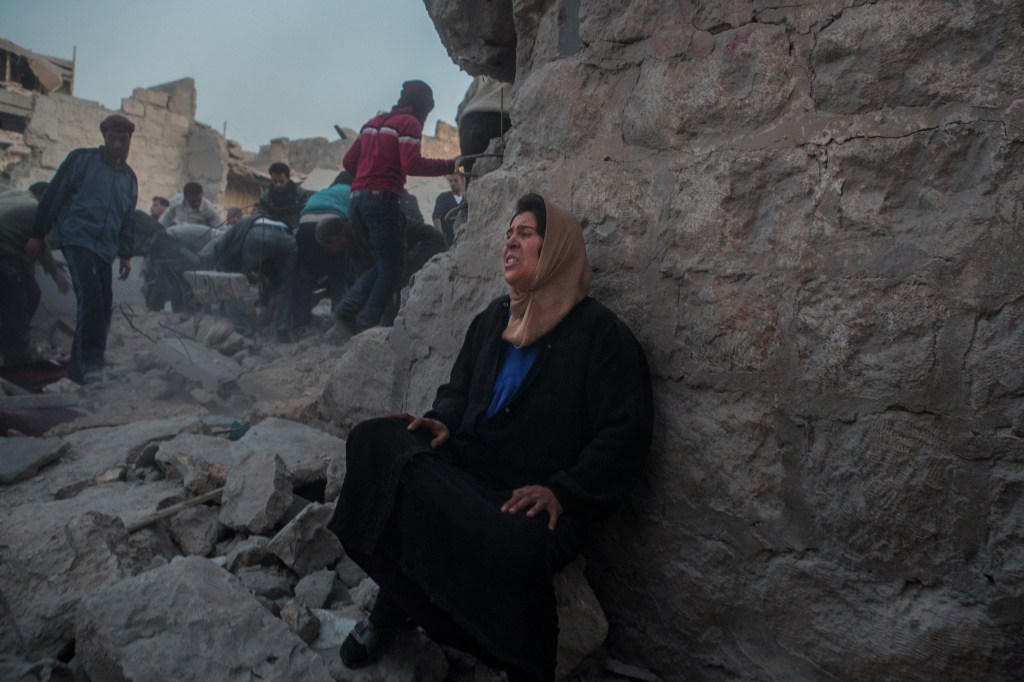
A woman cries in despair amidst the rubble of her neighborhood moments after an aerial bombardment released four to five parachute bombs in the Karm Homed neighborhood of Aleppo, Syria, on Monday, March 18, 2013. Approximately 26 people were killed and over 60 were injured.
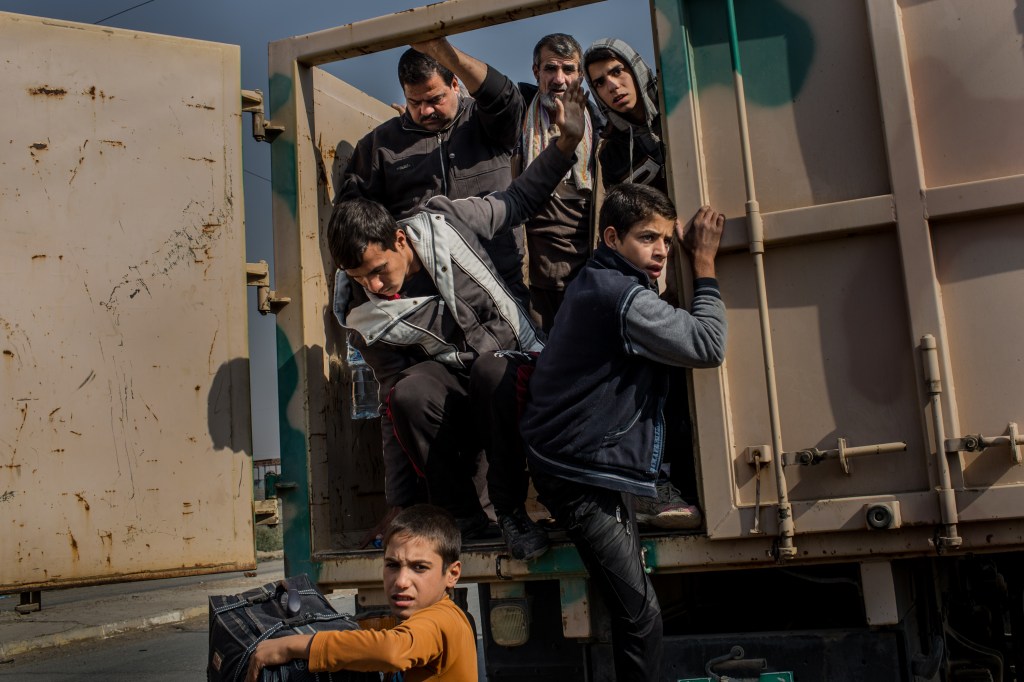
A convoy of men fleeing from Mosul are taken off a truck to be searched and checked against a wanted list of suspected ISIS fighters near the town of Gogjali, Iraq, on November 7, 2016. Iraqi security forces have been conducting rigorous checks on fleeing civilians to ensure they were not collaborating with ISIS, but their methods of interrogation have drawn criticism from rights groups such as Amnesty International, saying that torture and executions of Sunnis is in part due to revenge attacks.
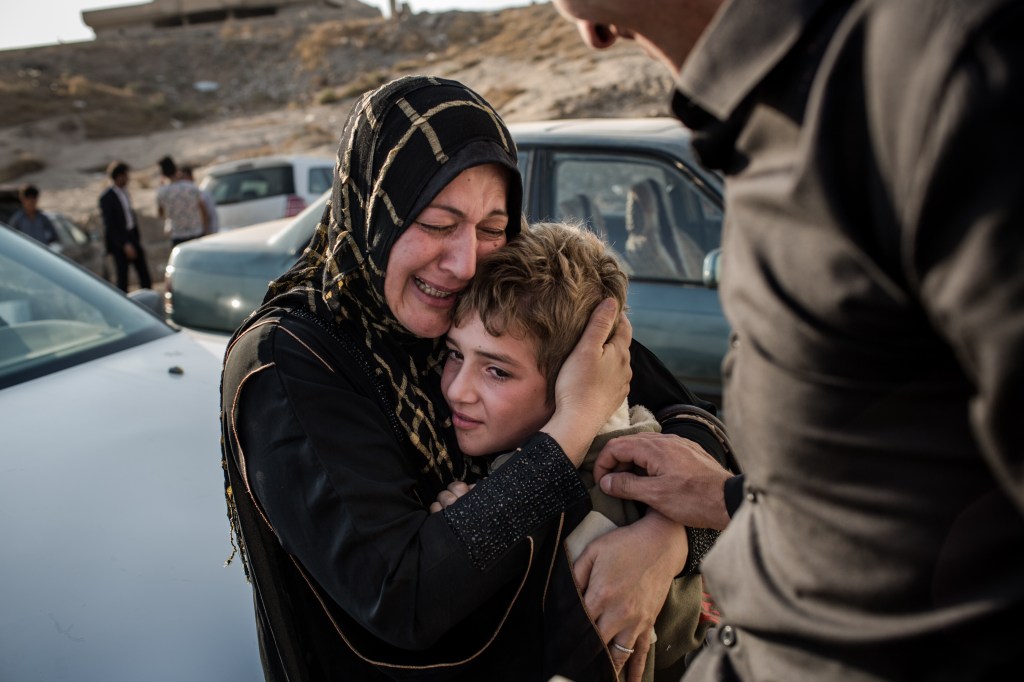
A mother cries while she cradles her son Laith, whom she had not seen for two years as they were finally reunited at the Hassan Sham camp for internally displaced persons near Mosul, Iraq, on November 7, 2016. Laith was trapped in Mosul when it fell to ISIS in 2014. LaithÕs mother, who could not go back to their home in Mosul, was forced to stay outside of ISIS territory, longing for the day to see her son again.
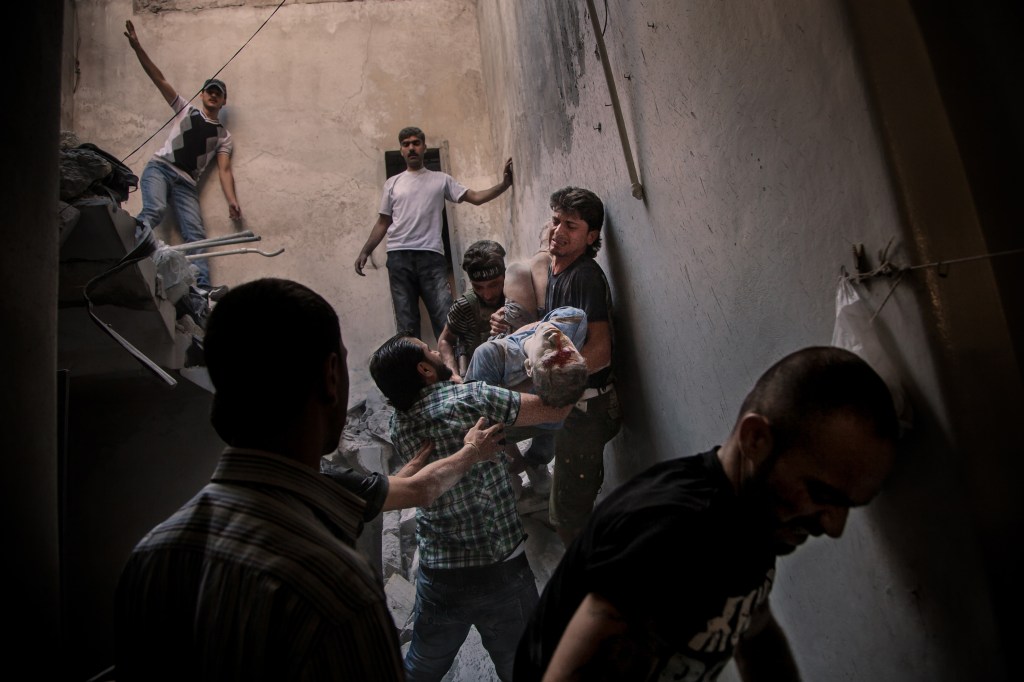
Men carry the body of Hatem Qureya, 15, after he was trapped under rubble following an airstrike in the neighborhood of Bustan al Qasr in Aleppo, Syria, on Monday, August 6, 2012 which claimed at least eight lives including five children from the same family. Hatem later died en route to the field hospital. At least two people, including a child, were trapped under rubble, complicating rescue attempts.
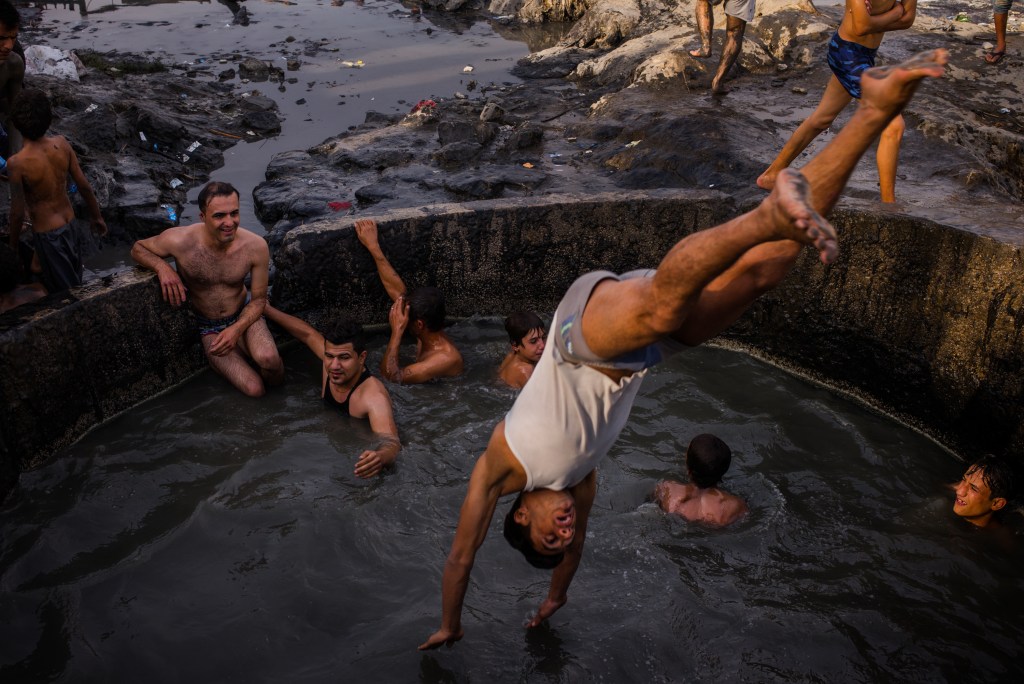
Life after ISIS: Men bathe in thermal baths in Hammam al Alil two days after Iraqi forces liberated the town from ISIS as they retreat further into Mosul, on Wednesday, November 9, 2016. As the offensive to retake Mosul continues, over 40,000 civilians have been internally displaced, straining already overloaded camps in the region. Hammam al Alil, under ISIS control for over two years, has seen the return of a trickle of civilians to their homes despite improvised explosive devices left behind and sporadic fighting between ISIS recruits and Iraqi forces.

Schoolchildren exit a bus in western Mosul, Iraq, on Monday, November 6, 2017. Since Mosul was declared liberated by the Iraqi forces four months ago, some schools have reopened in the city where many children have missed years of their education.

Ahmed, 12, from Sheikh Fares neighborhood, waits with his uncle, right, near the body of his father who was killed by a shell in the Sha’ar neighborhood of Aleppo, Syria, on Friday, August 24, 2012. Ahmed, who saw his father die, was also injured in his back by shrapnel.

Soldiers with the Al-Hashd Al-Shaabi, or the Popular Mobilization Units (PMU), stand at their checkpoint on the bank of the River Tigris in the Old City of Mosul, Iraq, on Wednesday, November 8, 2017. Various groups of branches of the military and police forces control Mosul in the aftermath of the war, with the PMU holding several different neighborhoods and manning checkpoints into them. The PMU, which is a collection of several dozen militias, was created under the Iraqi Ministry of Interior, after the Shia cleric Ayatollah Al-Sistani called for a mobilization against ISIS. Most of the militias under the PMU’s umbrella are Shia, whilst there are also some Sunnis and Yazidis, particularly in Mosul and surrounding areas. The PMU have been accused of grave human rights abuses and exacerbating sectarian tensions, particularly against Sunni civilians by Shia militias, but Sunnis remain an integral part of the umbrella organization especially in Mosul where the majority of the population are Sunnis.

A boy walks through a street near his home in Qayyarah, Iraq, on Thursday, November 10, 2016, as an oil well burns nearby. Many streets and neighborhoods in Qayyarah look apocalyptic, with oil residue covering all surfaces, turning small streets into muddy oil slicks, yet children can still be seen everywhere playing outside. Dozens of oil wells were set on fire as ISIS fighters retreated from the Iraqi Army in August, before the start of the Mosul offensive last month. The oil from Qayyarah provided a huge source of income for ISIS to help finance its activities. Many civilians stayed in their homes during the fight to retake the town and remain there today despite the months of smoke clouds hanging over the town.

Tariq, left, Nisreen, and their five-year old daughter Roslyn, are seen on the day-long bus ride from Athens to the Greek-Macedonian border in the far north, as they continue their journey from Syria to Germany, on December 19, 2015.
Over 1 million refugees and migrants have reached Europe’s shores this year, overwhelming the continent and presenting the worst refugee crisis since World War II. Many thousands have been fleeing from conflict in Syria, Iraq, and Afghanistan, while thousands of others, from Bangladesh, Iran, and Pakistan seek better livelihoods. The recent Euro 3bn deal struck between Turkey and the EU, intended to stanch the flow of people, has resulted in Turkish authorities cracking down on the smugglers and rounding up refugees, preventing them from making the sea crossing, but some continue to persist.
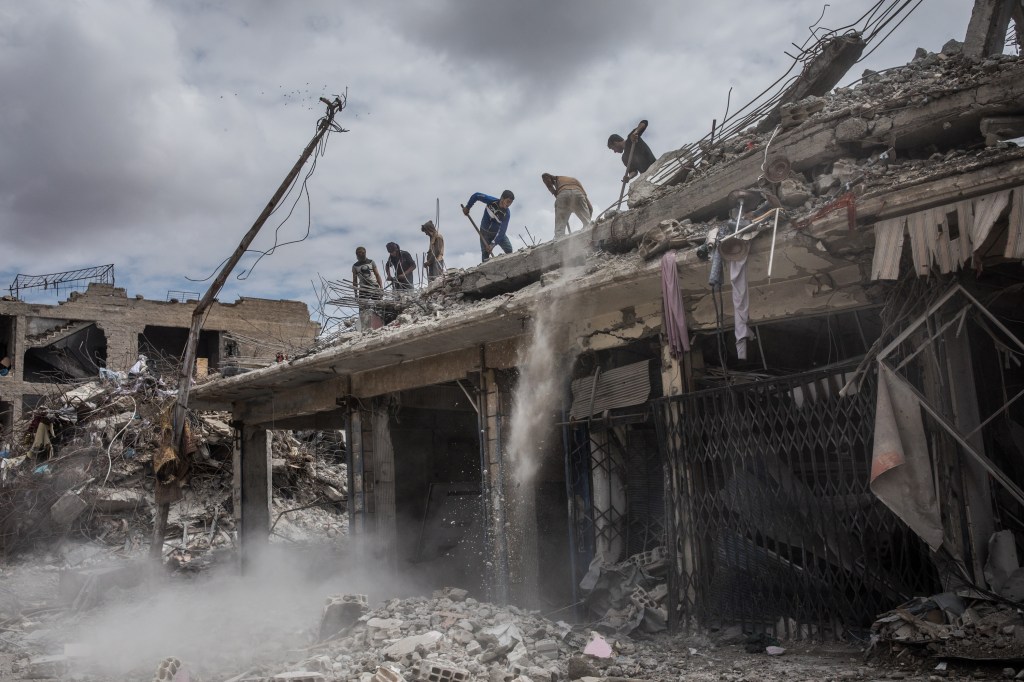
Construction workers remove rubble from a destroyed building in Raqqa, Syria, on Wednesday, May 9, 2018.
Seven months after ISIS was ousted from their capital, civilians are returning to rebuild their lives and homes. Without a visible presence of NGOs or strong support from the coalition because of ongoing security concerns, the cityÕs residents and civil council and municipality have taken it upon themselves to clean up the rubble and reopen stores in time for Ramadan. An estimated half of the 400,000 civilians – the number of people who were in the city before coalition airstrikes began last June Ñ have returned to a city devastated by airstrikes, street battles, and unexploded ordinance, including mines and booby traps left behind by the extremist militias. Infrastructure like bridges connecting the northern and southern parts of the city have been destroyed, forcing people to use flimsy barges to transport their vehicles, crops, and other goods to the city center. Late rains this year have also compounded the cityÕs woes as it relies heavily on agriculture. Bodies also remain under the rubble, worsening fears that disease could easily break out as the weather becomes warmer.
 Nicole Tung is a photojournalist born and raised in Hong Kong. She graduated from New York University in 2009, double majoring in journalism and history and freelances for international publications and NGOs. Nicole primarily covers the Middle East, where her work often explores those most affected by conflict and the consequences of war. She remains focused on visually conveying the fallout of the Arab Spring, the aftermath of ISIS, and the ongoing situation for refugees from Syria and Sub Saharan Africa. Nicole has also documented the lives of Native American war veterans in the US, as well as former child soldiers in the Democratic Republic of Congo, and pro-democracy protests in Hong Kong. With the support of the IWMF Grant for Women’s Stories, she recently completed a project on the rising violence against women in Turkey.
Nicole Tung is a photojournalist born and raised in Hong Kong. She graduated from New York University in 2009, double majoring in journalism and history and freelances for international publications and NGOs. Nicole primarily covers the Middle East, where her work often explores those most affected by conflict and the consequences of war. She remains focused on visually conveying the fallout of the Arab Spring, the aftermath of ISIS, and the ongoing situation for refugees from Syria and Sub Saharan Africa. Nicole has also documented the lives of Native American war veterans in the US, as well as former child soldiers in the Democratic Republic of Congo, and pro-democracy protests in Hong Kong. With the support of the IWMF Grant for Women’s Stories, she recently completed a project on the rising violence against women in Turkey.